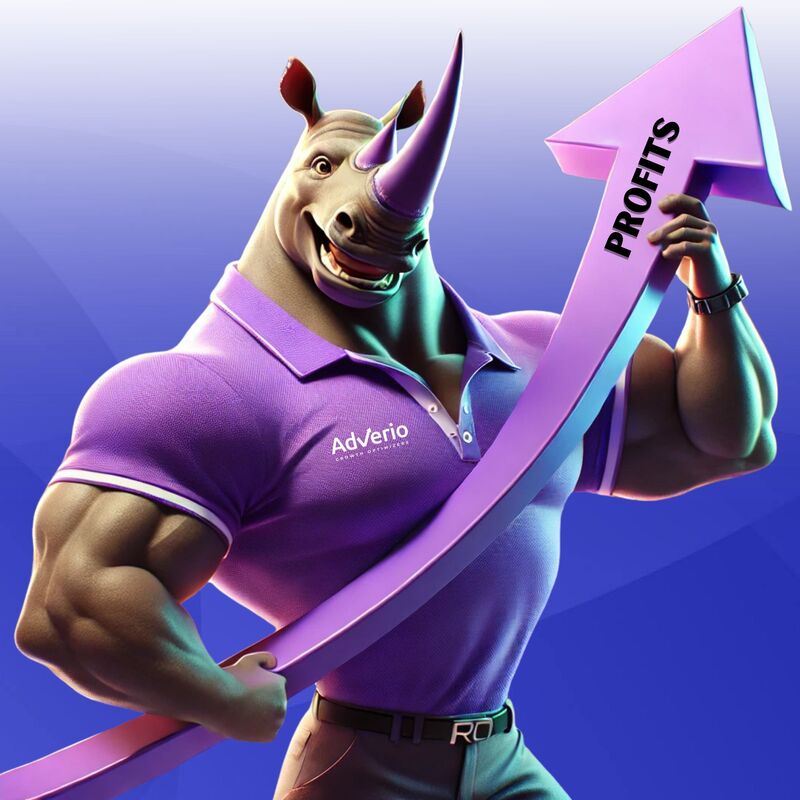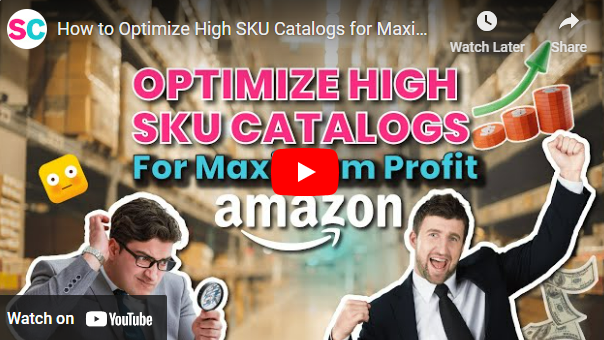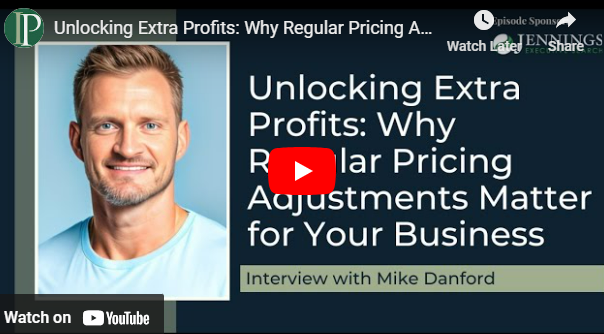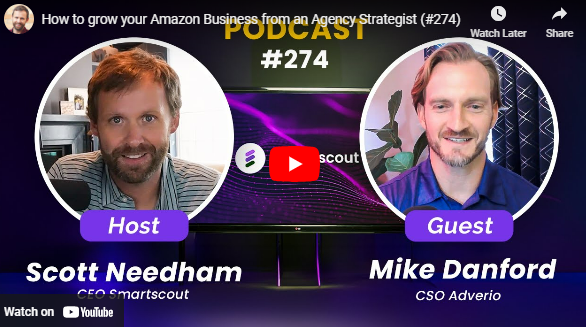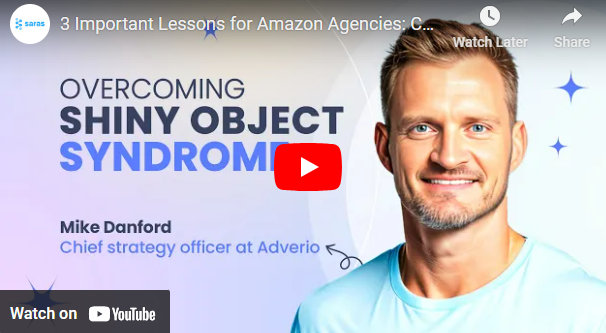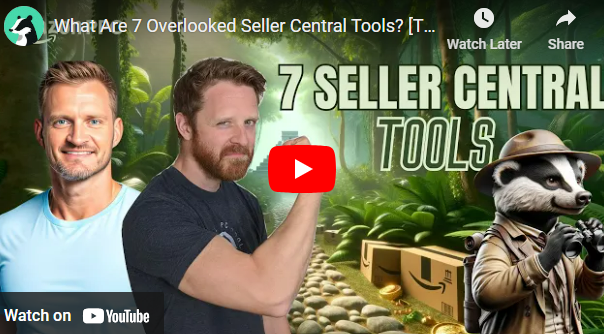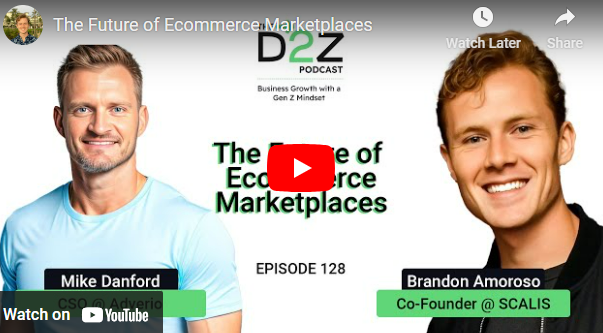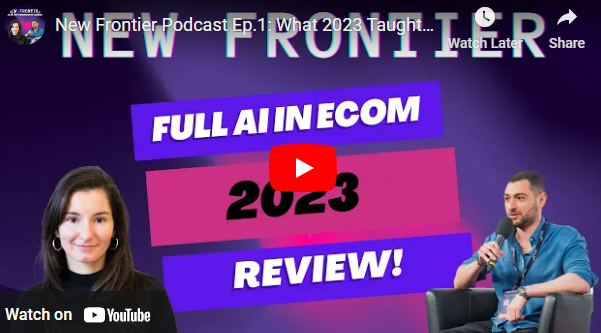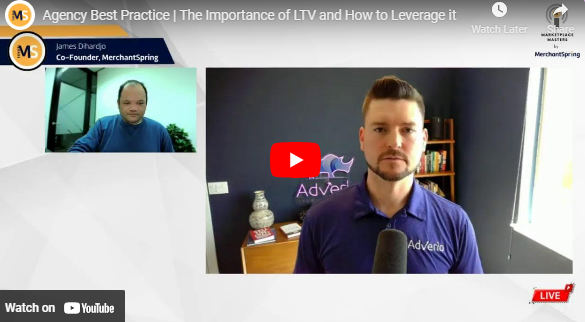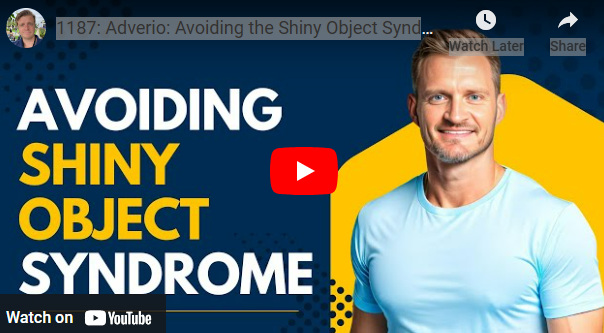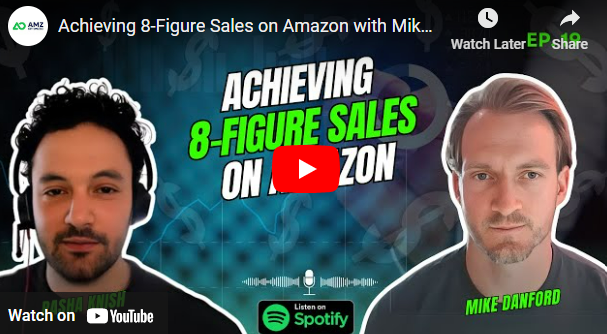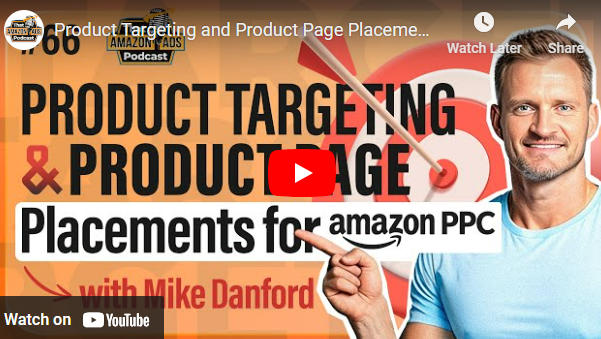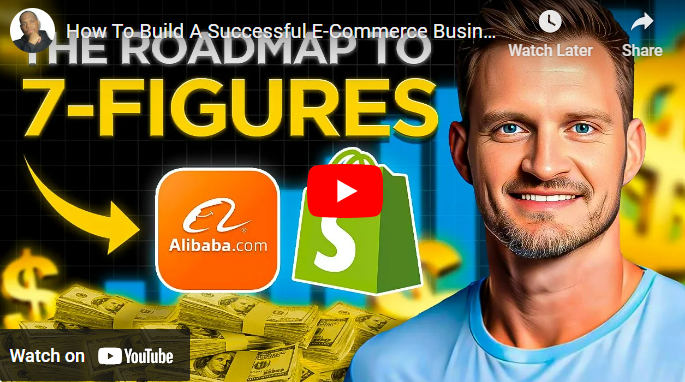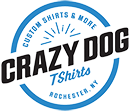Myles Youngblood/ Beyond Ordinary Podcast
Great people doing great things to inspire you to do the same
E-commerce expert, Mike Danford, shares his insights on scaling a business to 7 figures. Mike offers practical advice on selecting the best products, tracking essential e-commerce metrics, and leveraging organic traffic for growth. We explore how to avoid common mistakes, when to pivot your marketing strategy, and the importance of customer retention. Mike also reveals the key strategies for staying ahead in a shifting market, setting yourself apart from competitors, and using AI and technology to thrive in the e-commerce world. Whether you’re a beginner or looking to take your business to the next level, this episode is packed with actionable tips!
- 00:00 – Overview
- 00:30 – Introduction to Mike Danford
- 01:43 – How to Choose the Best Product for E-Commerce
- 06:19 – Knowing When to Pivot or Adjust Your Marketing Strategy
- 08:37 – Key E-Commerce Metrics to Track
- 10:56 – Boosting Business Growth with Organic Traffic
- 14:27 – Common E-Commerce Mistakes to Avoid
- 18:01 – Is E-Commerce Suitable for Beginners?
- 21:49 – Identifying the Ideal Collaborator for Your Product
- 25:28 – Strategies for Retaining Customers
- 28:06 – Scaling Your Business to 7 Figures
- 31:10 – Knowing the Right Time to Invest in a Product
- 33:00 – Staying Ahead in a Shifting Market
- 35:38 – Setting Yourself Apart from Competitors
- 37:52 – Training Employees for Optimal Performance
- 40:00 – Managing Profit Margins in E-Commerce
- 41:51 – The Role of A.I. and Technology in E-Commerce
- 46:27 – Anticipating Market Shifts and Preparing for the Future
[00:00:00] Myles Youngblood: What’s going on everybody and welcome back to the beyond ordinary podcast. I’m your host, Myles Youngblood. We got another special guest here with me today. We’re going to be talking everything e commerce. We got Mike Danford. He runs an eight figure e commerce company and we just going to get right into it.
Mike, how are you doing today? My good, my good man.
[00:00:20] Mike Danford: Yeah, great. I was looking forward to diving in. Thanks for having me.
[00:00:24] Myles Youngblood: Yeah, no problem, man. Let’s start off by telling the people, you know, who are you and what are you doing and go from there.
[00:00:30] Mike Danford: Yeah, absolutely. My name is Spike Danford. Um, I’ve been in the e com space since early 2014.
Lost a few products, uh, been in the health space and then apparel space as well. And kind of found out that one of my most expensive hires was around advertising, so brought that in house. Um, and I was like, Hey, this is numbers. I can figure it out from there. Um, and now, you know, 10, 10, uh, 10 years later touched a lot of different categories, um, understanding how to work with large catalogs and the complications that come with having more and more products, uh, and then being on different marketplaces such as Amazon, Walmart, Target, did Instacart for a little while.
Um, Shopify and Google and everything that comes in between. So, uh, products I feel like are, um, A lot easier or better for me, um, in certain ways and it’s, it’s fun to kind of stay on the pulse and each platform is unique and being able to find those nuances, uh, and leverage that, you know, the opportunities there.
So it’s been a fun ride and I don’t see it stopping anytime soon.
[00:01:37] Myles Youngblood: Uh, definitely can’t stop the gravy train, man. So you touched on something important about products. So my first question to you is how do you approach selecting the right products to sell on Amazon, especially since e commerce is a highly competitive market?
[00:01:50] Mike Danford: It really depends. Uh, for most brands, I would say I’d recommend getting something that you know, um, or already know of a void or a product that can’t quite, uh, meet the needs that you have. You know, there’s a great story with, uh, I can’t think of his name right now, but there’s a Corgis. We have a Corgi and my wife is all about the Corgis.
And, uh, there’s one Maxine and this guy basically was, you know, sharing a life with the Corgis for a year or so and then developed a backpack for it. That’s very specific. Um, for the corgis, et cetera, no tail, whatever, and no advertising, no marketing launches a product and it goes out of stock with, you know, I think it’s like 14 minutes of being live.
Um, now obviously that’s a unique situation, but it’s very similar to that. You know, the more passionate you are about your target market and who the product serves, the better. And my first product was a formulation for joint supplement. Uh, to help my dad, um, he has, um, osteoarthritis and, you know, the OTC, the formulations that were out there, uh, didn’t quite give him the response and the anti inflammatory properties that he needed.
So I sat down and research it. Um, and obviously he was my first, you know, customer and then the rest, you know, his history from there. And then, you know, supplements for me, you know, what I wanted, it’s very expensive if you’re doing that in your net space. Um, intensively and, you know, everyone’s trying to make up the mark mark up on it.
So it started formulating my own, um, sweet, you know, three posts and intro workout. And then, you know, from there, it’s just again, picking on what, you know, looking at the audience and looking what’s out there. We commonly look at the reviews and what the sentiment is for a product, especially a top seller.
What are they missing? What are they doing? Well, were they not doing well? How can we do it? Um, from there and then once you do that, it’s kind of having the synergies in the product offering that you have. It’s how can we create the efficiencies and economies of scale and in multiple of the marketplaces, you can have market basket analysis and you can kind of see other products that are being purchased with your products or are being shopped and kind of a window shop along the journey of your products.
And hey, can I offer that sometimes it’s as simple as a different color or different size of variation. Um, and then others, it’s a little bit different of a product where people who have this audience or in this space looking for this product also have an affinity to purchase these types of products.
Can you bring that in your brand? Um, you know, there’s, there’s really. Um, there’s so much to be honest with you. That’s how we look at it, go with the data, you know, the data is helpful. Um, and then, you know, it’s, it’s really what we’ve come to find out is, you know, you’re going to have some singles, doubles, triples, and all runs, and you just got to be prepared for that.
And not every product you think is going to do well, will do well. And then we have products that sit on shelves for a couple of years and just wasn’t the right time that we were ahead of the curve. You got to bring them back, throw a little bit of money at them. And you’re like, Hey, this, this product is, you know.
Uh, doing well now, you have that all the time, especially with large catalogs. So, it’s um, it’s, it’s a combination of a little bit of gut and a little bit of data, and then you just gotta be, you gotta figure out a process. Um, we also work with some brands that have a, kind of like a pilot program that they go through, where they have to think it’s a good product, they’ll kind of do the MVP, minimum viable product, get it out there and just kind of see what sticks.
And if it does well, then they’ll reorder, push, and go again. Um, and then we have others that they just sling out tons and tons of products and, and see what spaghetti sticks and goes from there. It depends on what kind of product market you’re in, what your cogs are, your costs to development, um, and what makes sense for you.
And try not to have too much capital tied up in the beginning until you know, it’s going to work. It’s definitely the, the, I think the big trick that a lot of folks, uh, will go, you know, all in, uh, before the product’s proven. And that’s the biggest mistake that we see. So.
[00:05:45] Myles Youngblood: Absolutely. That’s pretty much why I was telling you off camera, like I didn’t start, uh, FBA is because I was like, damn, like you need a whole lot of capital up front in order to, you know, get the product.
And I was like, damn, am I really going to put, you know, thousands of dollars into this product? And I have. Absolutely no idea if it’s going to work. So that’s why I was like, you know what, let me go with a different model that has a lot less upfront costs, which is why I decided to start a marketing agency instead.
[00:06:09] Mike Danford: And arbitrage is pretty good for that. I mean, I did some arbitrage at the same time in the beginning selling slinging Nike’s, you know, Hey, you know, people are going to buy Nike’s just switch ones. Right.
[00:06:18] Myles Youngblood: In terms of, you, you mentioned how. You had products and some products you had to sit for for years, which that’s actually I didn’t know that some people, you know, show products for years and then they bring them back on.
So my question to you is, when do you know that it’s time to move on from a product compared to its time to switch up the marketing strategy for promoting that product?
[00:06:41] Mike Danford: It’s a great question. Um, I think it depends on how much you have tied up in the product. At least that’s what we do. If there’s not much tied up into it and maybe liquidating it or getting rid of it, um, is more costly than to, to your point earlier, letting it sit where you have some space, um, I think that that plays into it.
And then there’s, you know, once you’ve pulled, as we say, a few levers and maybe different marketplaces, different audiences. It doesn’t work. Um, it’s, you know, it’s generally time to, to call it, um, and there’s usually, you know, trying to find out ways to, to find a secondary market or a way. Can you rebrand?
Um, is there any way to, you know, sell it on a different marketplace? That’s, you know, lower costs. Um, I mean, there’s a list of things. It’s not, it’s not straightforward. I wish it was. It’s, yeah. And again, we, we do, we do like to sit on and we try to say, Hey, you know, it’s not, some products are randomly for a year, but it’s usually six months to a year and you just kind of revisit again, if you’re being innovative and there’s just not the demand or the, you know, the people don’t know that the product exists, it’s kind of hard for them to find it on certain marketplaces and then somebody will post something and go in the general product will go viral or it’ll start to have a little bit of search traffic and then you can, um, you know, start pushing more traffic to it.
Um, and then sometimes it’s just you’re, you’re out of the game. You know, we had some products like, you know, make an extra hand sanitizer and, and, um, PPE during the COVID and trying to figure that out. Right. Kind of, that’s the whole process. And then can you repurpose the product? Is there a way to repackage it, um, add more to it or break up the product to, to the one thing that somebody does want, maybe they don’t want all of the, the eight bars that are in the pack, or maybe they only want a two pack or different ways of doing it.
So just being creative, especially if there’s a lot of, um, inventory capital, um, tied into it.
[00:08:29] Myles Youngblood: Yeah, definitely. You don’t want to waste that capital trying to, you know, you want to rebrand it as much as possible. Um, so I know you also mentioned earlier about metrics and data and that this is a very data driven, um, business model.
So what are some of the important metrics that you look at? In terms of whether a store or a product is successful or not.
[00:08:52] Mike Danford: Yeah. One of the most common that we’re going to go in is kind of a percent of the products margin that’s going towards advertising and generally on marketing on each platform, and that seems to help us kind of keep the pulse of, you know.
Not putting too much into it, not having it where it only relies on, you know, paid traffic as opposed to organic or non paid traffic. Um, and then it’s, from there, it’s kind of comparing the, to that point, the organic versus the paid. And can we get more organic over time and less depending on those ads?
That usually means it’s something they’ll stand on and so on. And then, you know, from there, it’s. You know, when you look at advertising, a lot of people will look at row ads, et cetera. And it’s really an efficiency metric. It’s not an efficacy of how well the ads are working. Uh, so it’s, it’s understanding the nuances behind that and really having your two or three KPIs that you are understanding and you can get a pulse on what the, what’s going on and where you should or shouldn’t go.
Uh, from there and it’s, you know, sometimes across the whole catalog, you understand your margin and then also at a product or a, you know, a group of products, um, as well. And then, you know, looking at a lot of folks will, you know, look at month over month, you got to tie in seasonality and also what’s going on with the market.
That’s a big part of it as well. I feel like year over year is often neglected. Um, some of the marketplaces that we work on, it’s hard to get year over year data unless you store it yourself. So that’s a big part. Is having a solution that works for yourself and can help you answer those questions. And now we’re, you know, we’re tying in machine learning, um, you know, AI, NLP and some other things as well to kind of help us kind of understand where the market might be going before we’re to where we’re more proactive as opposed to reactive.
And, um, I mean, that, that opens up a whole new set of models and analytics and ways to think about. Uh, where to or where not to go moving forward.
[00:10:50] Myles Youngblood: Mm hmm. No, I bet. Yeah, we’re for sure. We’re gonna get to A. I uh, later in the interview, but one thing that you touched on was about the organic versus the paid traffic.
So, and obviously everybody likes organic traffic because it’s essentially free traffic. So what are some of the best ways that you’ve seen or that have helped you grow your business, um, to seven, eight figures utilizing organic traffic?
[00:11:10] Mike Danford: Yeah. So for organic traffic, you know, I guess it’s technically not fully organic, but especially when you’re pushing on your product and trying to get that traffic and get those signals, depending on which marketplace or platform you’re on, you know, the influencer, the affiliate push right now is, is pretty big and platforms are starting to reward more organic placement based off external traffic that comes.
They don’t always know if the external traffic is paid or not. They just know the traffic is coming to this. Listings and converting from there. Um, and that’s probably the last year and a half or so that it’s really picked up. And that’s how we, you can also, you know, jumpstart organic on one of those platforms by driving some external traffic.
It could be from your email list. It can be paid. It can be, you know, social. Um, but now there’s a lot of, you know, influencers and, you know, face entrepreneurs, if you will, that can help you get those signals and get those different audiences and bring them in. That’s a good way to get to start. It’s pretty hard to get a grassroots, truly organic.
Um, unless you’re building the hype in the audience ahead of the launch and you kind of bring them in and get your first 100, if you will, for the product, but it’s really kind of, you know, having that email list or that database, you can go for each new product and ways to remarket and retarget them, whether again, that’s paid or organic to get that initial boost.
Um, once you do that, then the organics is a lot easier to maintain from there. Each platform, you know, it’s, it’s just, uh, being a part of each program in each platform, they have a lot of betas that come out. And it seems that if you’re enrolled in more of those and you’re willing to do that, whether it’s a coupon or a discount or a deal or whatever it may be, or a placement that they have, enrolling in those, it seems that they kind of reward you for being an early adopter in some of those programs.
And I feel like the more and more that we are involved with the, I think they give us some weight on that on certain platforms as well. It’s not, I can’t objectively tell you that, but it’s definitely a little too, um, too consistent for it not to be. Um, and then, and then it really depends on which kind of vertical you’re in as well.
You know, certain products do better with, you know, uh, organic, you know, UGC, user generated content, posts, Tik Tok, whatever it may be. And other products just don’t do that. They just don’t have that, that audience that, you know, they’re more of a, I need this right now because I’ve got X, Y, Z problem. It’s not a thing where like, Hey, I just want to buy it because I’ll have it in the closet, you know, whatever it may be.
So you have to kind of place that in when you account for that and you have a good, you know, go to market or a go forward plan, I think it’ll help. Um, and you have to, now it’s, there’s so much pay to play. It’s way more pay to play than it used to be. You know, what do mean by
[00:13:49] Myles Youngblood: pay to play? Pay
[00:13:51] Mike Danford: to play. Like in order to be in front of the audience on these platforms, you have to have paid placements.
Um, if you don’t do that, they’re just not going to, you know, like, Hey, you’re not willing to play. So it’s really hard. Or the. Organic placements are pushed so much further down the, the search result page or in your, you know, the listings, et cetera. So you have to pay to even get into, um, top of the folder where the audience is and where they click, um, which is unfortunate, but it is the, it is where we are in 2024, you know?
[00:14:22] Myles Youngblood: Yeah. It’s kind of just the nature of the beast. Um, pretty much how it goes. So in terms of your e commerce journey, what were some of the biggest mistakes that you made when you first started selling on Amazon and how did you overcome them?
[00:14:34] Mike Danford: Man. I mean, so my first product, I mean, I don’t even include it in my story.
If you will, we did like a spatula and it was the whole thing kind of learn, you know, don’t cut the corners on the R and E product development. And really it’s the quality, um, really have a good QA, really understand how to make the product. Last, I mean, we know this is, it’s so much different now for products and durability and the cost and everything’s involved with it.
So if you have a good product and it fits the need, um, and it will last, you know, longer than the value or what the perceived value is. And you’re in a good space, um, from there and, you know, it’s, it’s. If you can be a user of your product, I think that will help go a long way. Uh, we had a, uh, food torch that, uh, very long story short on the packaging didn’t clearly illustrate that you have to refill the butane upside down.
So everybody’s trying to refill the torch up, uh, right side up and it doesn’t work. It won’t go in there and only a certain amount will go transfer into the torch. So that was pretty costly having to redo the packaging and it, you know, it was takes a few months for that to kind of trickle through the reviews and you’re like, wow, it’s simple as flipping it over.
Um, stuff like that. And it’s just, again, trying to answer as many questions as you can before they purchase the product. And then once they purchase the product, how to answer as many questions as you can for them, whether that be in your email, your packaging, etc. Um, that way they’re not unsure of. How to use the products and then obviously leads to a negative sentiment review, customer service, et cetera.
So, um, those would be the biggest takeaways for sure. And there’s all kinds of other issues, you know, over ordering, not ordering enough and really trying to, you know, be predictive. If you could find out how much you’re going to sell before you sell, uh, man, you’ve got it nailed. Um, and, and that just takes data before you get that.
And even then you still can’t, uh, once we have a couple of years of data on a product. It, it becomes much easier to understand what’s going to happen, but then you still have these random moments of, you know, as a social post goes or an influencer will pick up a product and it just goes. Gangbusters and it just breaks the whole thing or, you know, COVID hits or some other kind of logistical issue pops up and you’re like, Hey, I only have one supplier for this product.
I need to, I need to have multiple suppliers or I need to have a way to split up this shipment when it’s stuck here. Or can I, can I bring some air freight over while I’m trying to deal with sea freight and just things of that nature. Um, it all depends on your, your supply chain. And I think it’s one of the biggest takeaway for a lot of brands that I’ve interacted with over the last four or five years is a lot of people have much better supply chain and logistics and redundancies built during the pre COVID.
want supplier and figure it out. And now I think they’re understanding like, is this better for them? They actually have better margins now in some, I mean. Relatively speaking, because they can bring the pricing down. Hey, this vendor can supply it for me at this and kind of get a little bidding more, if you will, where everybody else is just kind of like a bit of one place.
It’s easy, straightforward, um, boots on the ground. Let’s go. Um, but yeah.
[00:17:52] Myles Youngblood: Yeah, man, you just been ditching a lot of game. Like I’m not gonna lie. I did not realize how much went into e commerce. Before I almost jumped into it. So would you say that this is a beginner friendly business model for somebody that’s literally never sold anything online or looking to make their first dollar online?
[00:18:09] Mike Danford: Uh, I would say that the retail arbitrage, as I mentioned, that’s changed. It’s obviously a lot easier some and more difficult, but if you can get into something where the brand is known licensing, so we have, you know, a couple of brands that I’ve worked with that. Have licensing. So you already know that the product is known.
You already know that there’s supply. I’m sorry, demand and people are searching for that. It’s just, can you be that supplier exclusive or otherwise, um, all in all, it’s you gotta have a good capital outlay. You have to. There’s a lot of moving parts. You don’t have to be prepared to have some losses and understand you’re gonna make mistakes.
Um, but trying to work with someone who has made those mistakes along the way or can help you reduce that learning curve. Uh, I wouldn’t say it’s the, I wouldn’t say it’s easy. You know, I’ve been, I’ve done Kindle as well, books, uh, eBooks, et cetera. Digital products are a little easier to get off the ground.
It’s, um, it’s just. It depends on what your time frame is, what your expectations, you know, most businesses will take years, uh, to get into the black, you know, they’re going to loss for, uh, you know, the first couple of years. If you do it right with e commerce and you figure out ways to manage it, you can, you can shorten that a lot.
Uh, being, you know, net positive in your first year is, it was amazing. It happens. Uh, but you have to be. You know, diligent and resilient and being aware to your point being, um, okay with abandoning and going on to the next product. I think not being too married to it is pretty impactful. Um, and then just reading, you know, reading the signals and understanding what the market’s telling you that’s good and bad about your product or good and bad about the market you’re trying to go after and just being an open sponge.
I think it’s helpful as well. Um, but to answer your question, I think there are other ways to make money online that are easier and less capital intensive. It’s, um, I mean the biggest brands, you know, they’ve been doing it for a while and they can sit on cash for a little while and kind of weather, weather the lulls and can’t, can go through the COVID, you know, those types of situations where it’s like, okay, I don’t really need this.
If you’re relying on the income, that makes it way more challenging, way more pressure. Uh, if you’re having someone that’s invested and they’re giving you, you know, targets, et cetera, that’s, that’s more complicated as well. Um, But it’s a good way to learn. You know, I, I would say, you know, if you don’t have a, you know, I have, I have a 13 year old daughter, but, and a mom would never support this.
So maybe we’ll cut this out. But, um, you know, I took it as, I didn’t get an MBA. So I just had my undergrad and I was like, I’ll take the money that I was going to contribute to an MBA. I’m going to try real estate. I’m going to try e commerce. I’m going to try service. I’m going to try Kindle and whatever sticks.
And I spent less than way considerably less than what my MBA would be. Um, within the first, you know, two or three years of doing it and in my net positive at the end of that two or three years was much higher than my MBA would have been until I retired. Right. Um, so that’s kind of how I see it. You know, you gotta be willing to do it.
And if you have someone to help you along the way, it’s got, you know, different, you know, right brain, left brain, a little more creative, a little more analytical, et cetera, someone to kind of help you. And it’s gonna be tough by yourself. Um, I mean, those would be my thoughts there
[00:21:33] Myles Youngblood: for sure. Yeah, it’s definitely tough by yourself.
It’s a little easier because there is the Internet, but it’s just one of those things where you just don’t know where you don’t know. Like I was telling you earlier, I started a marketing agency and I also started this podcast about about three months ago and I’ve just now started to really understand like.
The power of collaboration. I went to my very first conference last week and just got a wealth of knowledge that I had no idea. Um, when, as opposed to when I was just, me and my friends, we call it, we just, you’re in a cave and you got a candle and you’re just going through and you have no idea what you’re doing.
Yeah, you talk about
[00:22:09] Mike Danford: the island of one, right? Like you’re all by yourself sometimes.
[00:22:11] Myles Youngblood: Exactly, all by yourself. But yeah, I definitely see the, the, the benefit. of collaboration. And actually speaking of collaboration, my next question to you would be, how do you determine the right content creator slash influencer to partner with you on a product?
[00:22:25] Mike Danford: There’s been a few different, uh, different networks, different platforms have different ways of going about this. You know, some are going to be, you know, really, um, well thought out and larger campaigns. And those are usually going to, they’re going to have a little cost to them depending on what’s going on.
So you’re like macro influencer, if you will. And you have micro influencers, which is a lot of people putting a lot of little signals out there, a lot of, uh, different links for your product or products and coming back and then, you know, it’s going to come down to. You know, commissions and understanding what, what’s, what’s favorable for everyone.
What makes your products, um, you know, intriguing and interested for these influencers, kind of understanding what the influencer is looking for. If you have the time and the capacity to kind of understand the audience, you know, is it already saturated? Are they already promoting products? So they look at your competitors.
Does that make sense? And then, you know, you’ve got to have your kind of your brand style guide. And, and, and kind of how you want your image of the product, your brand to be spoke about. What do you not want? Like anything to be like, Hey, you can’t say this. Uh, or Hey, we’re not organic. We are natural. Or we are, we’re organic, not natural.
Those kinds of things, little nuances like that. And most of the influencers will pick that up and understand it. And then I think that the, the back end of that is being on which platform you’re going with. It’s getting access to that what we call UGC or user generated content, so you can use it in your advertising elsewhere.
Instead of having to pay to get a, uh, promo video created that’s maybe not UGC. It’s more studio based. So once you can do that, I think that’s how you get, you know, multiple birds with one stone, if you will, multiple uses of the same piece of content. And then again, just trying to make sure that everyone’s on brand without having too much of a requirement for the influence and you have a lot higher adoption and then, um, you know, creating a packaging and an unboxing experience and a few other things that make it.
You know, social media friendly and TikTok friendly and interesting. You know, if it’s a boring, bland package and it doesn’t quite make sense and you can’t look at the box or the bag or whatever it is. And like, Oh, okay, this is what this is. It makes it hard. You know, um, the more you can do with that, the better and make it more unique.
You know, we work with some other brands as well that I’m trying to help them understand how to like shape their. Uh, protein bar differently, like make it into a dumbbell or a barbell or something that’s unique to make it just different and all the rectangle bars that are out there and it looked the same.
And now you’re, you’re in a sea of, you know, blue and yellow and pink and whatever colors they have for the box. You know, how do you make your box stand out? Um, Mike Michalowicz is just one of my favorite authors and he’s got to get different, it’s one of his books that he has, and it’s all about thinking outside of the box and how to stand out.
You know, um, one of our mascots is a rhino and we’re like, how do we be the purple rhino amongst all the gray rhinos? Right. How do you, how do you find us? We don’t want to be where’s Waldo where you can’t find us. So I’ll make it easier. Right.
[00:25:22] Myles Youngblood: Exactly. Exactly. Always got to stand out. Always trying to do something different.
Um, for sure. In terms of, uh, what you call customer retention, what strategies do you use to ensure high customer retention and to get that repeat business?
[00:25:37] Mike Danford: Yeah. First is the quality of the product. As I mentioned earlier, if your, if your product product is quality, you’ll have word of mouth. You’ll have folks that’ll come back if it’s a consumable product to keep repurchasing, et cetera.
Um, if you have a new product that comes out, the loyalty will be much higher. It’s also, you know, appreciating and showing them the appreciation and having that, um, as many touch points as you can think about on thoughtfulness, you know. If you’re in the email, it’s, it’s a little complicated sometimes now, you know, certain platforms maybe where we can’t communicate with them directly because that platform owns the email.
If you have your own email list and, you know, again, how do you, how do you be different from the white noise? how do you stand out? How do you make it where they want to engage with whatever, you know, email you’re sending out, if you can educate, uh, your audience without, you know, trying to promote or push any product.
Um, then when they’re ready for a product there, it’s much, it’s much better or much higher. Um, you know, adoption of whether a new, new or repeat purchase as well. And engaging with the audience. There’s multiple people who are going to really support your brand. They’re going to fall in love with your brand.
If again, if you have a good products and you’re in your meeting, the need. And, you know, tap into them, Hey, what else do you wish that we made, or what do you wish that we did different about this and kind of having those, you know, brand loyalists, you know, be your, uh, evangelist, if you will, but also listen to them and kind of, you know, promote that and then, you know, compensate them for that if you can, um, with, you know, whatever it may be, you know, demoing or, you know, trying a new product before it goes to market or letting them know how to be a part of the pre release, et cetera.
Um, you know, just being creative in that way. Great. And then, you know, giving them a forum to reach out when things, you know, the product, maybe it got damaged in shipping and you don’t want that to be the reason that they don’t use the product and you just be willing to respond quickly and genuinely and it’ll go a long ways.
And then the last part of that is going to be digging into the data, like where do we lose them in the funnel? What’s the perfect cadence? What’s the timeframe to reach back out to them? What’s the sequence? You know, what should we include? Uh, when do we ask for a review? When do we ask them how things are going?
You know, how do we give them enough time to know the product is working, um, as desired, et cetera, and kind of figuring it out. And it’s, it’s usually, you know, There’s some general rules of thumb for, you know, each brand, but each product is kind of unique as well. So, I mean, there’s a lot more to it, but hope that answers your question.
[00:28:02] Myles Youngblood: No, it definitely did. So what did you do to take you from that six figure range to that seven figure, uh, business?
[00:28:11] Mike Danford: Yeah, absolutely. You know, kind of in the earlier conversation about, you know, finding products and, Hey, we already have these products. What else can we do from a term of combining multiple products together?
Um, so bundling them or having different variations or size or colors, um, that’s the easiest way to start. And then again, going in and so Amazon specifically has a market basket analysis report that you can get, you can tap into, and it will show you the top two other ASINs or products that are purchased with each one of your products.
And you can, you can see, uh, especially with AI now. It helps you manage, you know, larger catalogs and larger order accounts. You can see consistencies of other brands that are being purchased it. Other what’s your products, other products that are being purchased. And then if you’re really, you know, dig into it, you’d be like, Hey, there’s multiple brands and they all sell this type of product.
So there’s like synergies and other things as well. Go down those pathways. Um, and then again, just trying to be synergistic in your brand is I think that’s the best way if you want to go into another vertical, you most likely need to build another brand or another way of, you know, a larger brand and being able to separate those.
Um, so you’re not confusing your audience of, Hey, you know, I thought that your brand sold this and now you sell this as well. I don’t really. Um, I think that’s a big piece as well. You’re welcome to do that. And, you know, it’s, if you can have some seasonal products in there as well, tap into that. And it’s just like, uh, what is it?
Starbucks just released, you know, their, you know, whatever the pumpkin spice, right. And that’s a big thing every year. It’s only available a certain time of year. Um, you know, we do that with flavors and other things as well as like, Hey, they’re only available this time. Um, that’s a big part of it. It’s just being creative.
And then, you know, again, engaging with the audience and asking them what they’re wanting, Hey, uh, if they could release X number of products in the next, you know, whatever, what would you want, what else are you looking for? What else can we say? Well, I wish you, I wish you sold this, or I like this flavor, or I wish you had this pack, or I like this box, whatever it may be, it’s so random.
But if you ask enough people, you’ll, you’ll start to see that. Um, yeah, I mean, I guess that would be the biggest thing. And then, you know, looking at your, your cogs. So sometimes we’ll do an analysis, you know, Hey, we’re going to, we’re going to go after this product. We’re going to build this product or this style or where it may be a year ago.
And for whatever reason, it must have been, may have been a shortage in supply or whatever may have happened. And it made the cogs too high for, you know, it just made a price. And now those products or those, those raw materials are a third of the cost that they were a year ago. Now let’s revisit. Is that because.
Supply demand both. Uh, sometimes, sometimes you can, when you scrap a year or two ago, you can bring back and like, Hey, this is much more cost effective for us now. Um, that’s, that’s a pretty cool way of doing it. And we usually try that once a year. Um, I wish we could do it more often, but it’s kind of hard to dig into that.
But, um, yeah, I think that’s a cool little, little hack that we have.
[00:31:09] Myles Youngblood: So when do you know when to put more money into a product to make more from that product and then to when to add a product?
[00:31:20] Mike Danford: That’s a great question. So in certain marketplaces You can have an idea of what the cap is when the markets share in that particular marketplace And then you’re trying to understand what’s my marginal cost in order to acquire more customers and you look at your customer acquisition costs versus LTV and does it make sense, etc.
And they’re all going to, you know, reach some kind of, you know, uh, point of. Plateau, if you will, or equilibrium where it’s like, okay, and then for us, well, it’s usually a push for a little bit, maybe a month or two, see what happens. Do we have any growth? Do we increase our market share? Do we have more top line and less focus on bottom line for that month or two?
And it was, yep. Okay. Then you pull back and you say, Hey, can I keep this new level of cells and bring back my efficiency and reduce the, you know, the aggressive push and keep that same level of cells. Uh, if that happens and you just keep doing that until that no longer works, it will all, you know, must always be a point where you’re going to push and you’re going to increase or you’re going to push and you don’t increase anymore.
There’s your answer right there. Like that would be very challenging. Um, and then sometimes it’s about season, like I said, you know, revisiting products that are a little stagnant, you know, let them sit there and do their own thing, kind of rely on more organic cells and then six months or a year later, push them a little bit more and see, you know, the market changes.
So often, um, you, you never know what’s going to happen, but, um, and then, yeah, I mean, that’d be the big determining factor of how we know where it’s at in its product lifecycle. Uh, can we get more juice for our squeeze and is it sustainable? Um, yeah, it’d be the biggest cycle for us.
[00:33:01] Myles Youngblood: So you touched on something in terms of the market is like constantly changing.
So what are you doing in order to either stay ahead of the market or be able to pivot with the market quick enough?
[00:33:11] Mike Danford: Try to rely on as much data that comes from each platform, because each platform is completely different. Uh, also it’s kind of tracking, you know, is everyone else, is everyone else’s sales down?
Is this, is this seasonality? Is this a, you know, is there a new competitor in this space? You know, what, you know, trying to understand what that is. Uh, you know, there’s, there’s ways of doing it at scale, more data centric, but there’s also. Hey, you know, how do I, uh, split test my main image or my pricing or a video or anything of that nature?
So it’s just constantly testing it to understand. And if you see a competitor, and there’s all kinds of tools out there for most platforms you can track, you know, organic share, a voice, organic share, and mark, you know, page share, et cetera. And that’s tough because you can’t always. Increase your organic share or your paid share just by pushing more money after it.
Uh, you again you will reach a certain point where You know, the marginal return isn’t there and It’s just doesn’t make sense and you’re like, okay, it’s getting overcrowded or we even have where we’ll take a product that does really well and we’ll, we’ll rebrand it, maybe make a little bit of an aesthetic or a small, you know, visual change to it and then push it through the same promotion process.
And it becomes, then we become number one and number two in the market or number three and number four in the market because we can’t get our product that we’re already ranking really well for selling really well. to push higher. So we just do it again under another brand. Uh, that’s fun. Uh, it doesn’t always work as fast obviously, uh, but it is a way to, to think outside the box and to continue.
You already know how the product’s going to do. You already know the product’s going to do well. You already know what works in the product. You already know the manufacturer, you know, the cost and everything else. It’s just, uh, do that. I mean, we had a, um, years ago, a, uh, like a geriatric clock. That literally it just, we just changed a little bit on the dial.
It was the same thing. And it was like one, two and three for a while. I even Amazon came after the brand to, um, Hey, I want to acquire, you don’t want to purchase, but it’s also a way to stay below the radar where, you know, the certain platforms won’t realize like, Hey, you were taking up so much, the market share, and they’re going to like, try to come after you and try to copycat, et cetera.
It’s kind of like being your own copycat because you know what worked anyway. So why not do it? Um, that’s fun. Uh for sure,
[00:35:38] Myles Youngblood: so you you also talked about Uh, or just mentioned about people trying to like copy you, like, obviously people got all these tools where they scrape, Oh, this person is doing X amount of sales.
So like, how do you compete with that? You have to differentiate yourself
[00:35:51] Mike Danford: and constantly differentiate yourself and try not to, you know, you can’t race to the bottom of price. That’s hard sometimes. Uh, and you just you have to figure out a way to add more value and in your product as much as possible. Um, and then You know, just not get into that, that, that fighting match with that, that race to the bottom, uh, some products will kind of need that, especially if a lot of products come out.
Um, and then there’s just ways to point out quality, especially if the copycat, you know, isn’t quite the quality, you know, getting patents and, and protection on your designs and stuff is very challenging, especially if you’re overseas for any of these products. Um, and then, you know, it’s, it’s understanding if they’re going to be a long term threat or not, because when a product first comes out, a lot of data is skewed, you know, they’re doing a lot of promos and giveaways, and they may be losing money, and we have people that come in all the time, and for two or three months, they’re just beating us up, you know, this looks like they’re selling a bunch, they’re outranking us, etc.,
and they’re doing promos and heavy gifts, and then they’re like, Well, we just lost a bunch of money. This isn’t going to work. And they just dry up or they go out of stock. And then we, you know, it’s just a whole thing. I mean, on most platforms, we’re not stock is extremely detrimental to any kind of momentum you have.
Uh, so it’s have better inventory management and be more strategic. Um, you know, around any kind of pricing changes they do as a follow up, you know, as opposed to like leading in price or following in price or, you know, hey, just pull it back whenever they’re having a big push. Um, and just be, be willing to kind of take that for a month or two while they’re doing it and then come back and sweep in later.
Um. And sometimes you just can’t, you know, you’ll never be able to compete with someone that’s, you know, figured out a margin game and has a lot larger pockets to go after a product or, uh, things that nature can be willing to, to your point when you cut it and when you stop, you know, pushing and putting too much, you know, behind it.
Um, it’s a dynamic process. It’s not really a set, you know, a set and forget it or a set way of doing it for sure.
[00:37:51] Myles Youngblood: So in terms of hiring, what has been the most important hire for you to get to where you are today?
[00:38:00] Mike Danford: Yeah. Um, I would say that having someone to help with operations is, is definitely, uh, and I would say like organization, like of your org or your enterprise, where, you know, especially if your team increases and you have more, um, contractors or more vendors or anyone involved, it’s, It’s a lot more balls to juggle and place to spin, if you will, and having someone that can keep that so that you can keep focusing on innovating and pushing the business because as soon as you’re in the operations, it becomes very difficult to keep growing and innovating.
And, you know, honestly, I wish that, you know, we’d hired someone sooner that was more involved in that. Um, it’s also not necessarily my, my strongest point. Um. I think it’s, I think it’s the best thing is like higher your weaknesses as fast as possible. And then the rest will be a lot easier. And then that’s what I wish I would have done sooner.
Um, and then, you know, I mean, I think it was your question, best hire and worst hire, or was it just,
[00:39:02] Myles Youngblood: Oh, it was really just best. Or you can, you can, you can mention the worst or what kind of lost you, you know, it was my money.
[00:39:08] Mike Danford: Well, you know, I would say it’s not the, not the person that’s hired. It’s being prepared for the new hire, setting them up for success is definitely, you know, when you’re growing and you’re pushing faster, you, you pull multiple people in at the same time.
It’s making sure that they have the tools and resources they need. Um, that’s still still probably one of our biggest challenges is making sure that as a new role develops as a new service line develops or a new, um, product line, you know, being prepared and unless you’re able to hire someone that can build that for you.
But if you’re bringing someone in that. You know can’t build and you have to make sure it’s built for them And I wish it was a little easier to to dictate that and to anticipate that but sometimes the only way to find out is Just to hire, you know
[00:39:59] Myles Youngblood: And then a common reason why people don’t get into e commerce is because of low margins like, you know We’re talking like 20 ish percent 30 ish percent.
So what has your experience been?
[00:40:08] Mike Danford: Yeah. Margin is hard. It’s, you know, you got to look at the, the numbers and volume game and then it’s, you know, how much, how much capital you have to put into your MOQ or your minimum order quantities, how much you have to outlay, how fast can you produce? Um, are you willing to do that?
You know, what’s the, what is, what’s everyone else’s margin is kind of understanding and if it’s, if you’re not comfortable and you don’t want to be, you know, you’re going to be concerned with margins the whole time, then don’t do it because that’s the, that’s the biggest thing is just like, that’s not going to be fun.
Uh, you know, try to find a product, be patient that has the margin. Um, and then maybe it’s the first, you know, year or so the margin is not there, but once you hit a certain volume, like now I can double my margin. Um. You know, it’s, it’s, it’s being, you know, thinking longterm as opposed to short term as well, as I mentioned, you know, cogs can change your, your raw materials, your suppliers can change.
Once you have enough volume, you know, sometimes you can get a supplier that’s, you know, more, you know, negotiable and as a second supplier that’s like, Hey, this is easier for us and we can help reduce your cost there. Um, and then maybe you can, you know, redesign the product to make it more cost effective, um, for you.
And then, you know, it’s, it’s, how can you add more to that product or, or, or bring that basket size? Like, Hey, the person in this part, it’s really low margin, but when they purchase this, they, they, they want this, this, and this. So look at it as a whole. You know, a product, you know, may only have 15, 20 percent margins, but if you’re getting two or three of those products added.
And the margins, you know, it’s still percentage wise the same, but the order and the customer has more value, right?
[00:41:41] Myles Youngblood: Definitely. Increasing that customer value and all those upsells. I remember doing e commerce and you know, all that stuff at checkout were crucial. So in terms of technology and AI learning.
How do you see that shaping the future of e commerce, especially when it comes to marketing and product optimization? It’s,
[00:41:59] Mike Danford: I mean, it’s shaping it right now. It’s so hard to keep up with. It’s also not, you know, AI has a lot of hallucinations and lies platforms where, you know, AI is just a prediction. It’s going to spit out what it thinks you are looking for and what it thinks you want to see or were anticipating to see.
You have to ask it, you know, how confident is it? It’s a probability and prediction machine, right? So. When we communicate and, and, um, you interact with it, you, you got to understand like, is this, is this really, you know, how confident is it? So you have to ask it sometimes once you have the confidence in the answers, then it’s, you know, being able to scale from there.
And then for us, it’s. For us, it’s data. It’s crunching more data than we could do, um, through a Mac, you know, a macro, whether that’s an Excel or Google Sheets, et cetera. And then it’s having larger data sets and larger lookbacks and being able to look at data daily as opposed to weekly or monthly and being able to have smaller sets and just do that heavy lifting.
And then it’s, You know, what we’re at right now is taking, you know, two point five research, development, process improvement, whatever it is, kind of teaching the machine so that it can apply that and then have it asked that same debt, uh, set of data or images or whatever you’re scanning and looking at and how would it look at take your own bias out of it.
Um, it’s very hard when you’re training, very hard not to, when you’re training AI to, to train with your own bias. Uh, so a lot of times I like to ask it, you know, along the way, you know, what would you do? Just randomly ask before I even give it any information and tell it how I think about things. Um, that’s pretty cool.
And then, you know, right now we’re seeing a big push in, in being able to scan images and video and pull a lot of data out of those and understanding, you know, context. Yeah, the, the listing or the product may not have said that this product is good for outdoor weather or, you know, it can only tolerate 32 Fahrenheit or better or, you know, whatever it may be.
But if you have pictures and images and, and, and that kind of speak to that and show that the product can be outdoor, indoor, waterproof, water resistant, whatever, it picks up on those. And that’s pretty interesting because it allows you to. To stuff the listing with a bunch of copy, it makes it really hard to read or it doesn’t read very well, or, you know, just again, as I mentioned earlier, answer as many questions as you can when they land on your product page in as fast as you can, in a way that they want to digest it.
You know, the, the society now is all about, you know, images and video and, and, and digesting and, and consuming in that way as opposed to reading. Um, and then being able to just support it all the way through. Um. You can download a bunch of reviews and get NLP, Neuro Linguistic Programming, and kind of understand sentiments, positive or negative.
I mean, it just, it’s endless. Um, and then we have obviously service providers that will come to us and try to, you know, here’s, here’s an AI agent that does this. And here’s a way to think about it in different ways that we would never think about it. Um, and just being willing to. You know, absorb all that and make your own decisions over time.
Don’t, don’t, don’t jump the gun. Don’t have the shiny object syndrome. That’s very challenging. It’s advancing at such a fast pace. Um, I mean, I was looking at the, what the Y Combinator, and I think it was like two thirds or so, maybe 60 percent of the brands and products that are in there are, you know, AI based, at least getting tagged as AI based.
So there’s a lot coming. Um, I think you have to, you have to understand it. You have to not be afraid of it. It’s here. It’s not going anywhere. If anything, it’s getting more and more and the better that you understand it and can can interact with it and can, you know, fish it out and understand when it’s being used.
And, and then think about how can you do more with it? How can it make you know, your life better? Personal, professional, whatever it may be. Um, how can it help me reduce the mundane task or do more with the same amount of information I have? Um, and then, you know, have it communicate and help with ideation, you know, and I mean, the list goes on and on.
I could talk about this for an hour. I actually have, I’m actually going to do it next week.
[00:46:22] Myles Youngblood: That’s funny. That was funny. All right. Last question of the day. What trends do you foresee in e commerce over the next five years and how should entrepreneurs prepare for these changes?
[00:46:33] Mike Danford: You know? I, I mean, I like the question, but I also like, I think it was Jeff Bezos with Amazon.
He, he gets, he was getting asked that question pretty early on. He says he likes to flip the question for the next five or 10 years. What do you think’s not going to change? And that’s what he focused on. And that’s what we try to focus on as well. Um, as I mentioned earlier, um, so to Ask the opposite of your answer.
The opposite of your question is, I mean, we’re focused on what’s not going anywhere. And how can we build that stability while also being aware of what’s being developed? Um, you know, with a I can mention just just a moment ago. So that’s what we just asked herself. If I build this right now, am I going to use this in a year?
Two years, five years. Yes. No, is this going to be here? I mean a lot of things we already know is people want quality and they want cheap prices I mean those things aren’t going anywhere, right? So how do you do that? How do you how do you incorporate that in your products in any of your service or whatever you’re providing?
Um post purchase or whatever it may be if you can do that, I think you’ll you’ll stay in business regardless of what’s going on
[00:47:40] Myles Youngblood: Hey, I really like that reframe because instead of just trying to chase a shiny object of oh What do I think is going to you know be the next? You know, hot shit, but you just focus on, okay, what is working?
Let’s stick to what’s working. Let’s stick to what’s going to be evergreen. Yeah. So I love that reframe, but Mike, it was great having you on the podcast. Do you quickly want to tell the people what Averio is, where they can, everybody can find you all that stuff.
[00:48:05] Mike Danford: Yeah, absolutely. Thanks again for having me.
Obviously Averio. io. Um, there’s a kit in there where we have a bunch of tools that we’ve built and we give them out to other sellers as well. So if you just go to our tools, uh, free tools, um, there’s a bunch of them in there and we have what we call the eight figure toolkit, uh, which is a lot of stuff that we built, um, over the years and you can have access to it there.
And obviously LinkedIn, um, as well.
[00:48:29] Myles Youngblood: LinkedIn. Okay, cool. We’re going to put all that in the show notes for you guys. Beyond the Ordinary podcast. We just had another extraordinary guest. Until next time, peace.

